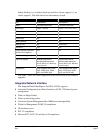
Version 0.3, 4 December, 2000 DCSE: PowerEdge 1550 Self-Study
Dell Page 1
Introduction to the Self Study Guide
Description
The purpose of this self-study is to prepare Dell Service Providers (DSPs)
to service the Dell PowerEdge 1550. It does so in various sections. The
first section identifies the target markets and the needs of those markets.
Then it describes the features that allow the Dell PowerEdge 1550 to serve
the needs of those markets
The next section describing how the Dell PowerEdge 1550 integrates into
a rack and how to remove/replace each field replaceable unit.
This is followed by an overview of the Dell Service provider (DSP)
program, the requirements of a DSP, and how to perform DSP specific
tasks such as changing the service tag number of a system board.
The final section, Technical Appendix, contains more in depth information
about the features of the PowerEdge 1550. Familiarity with this
information will aid the technician in servicing the PowerEdge 1550.
Goals
The goal for this document is to prepare Dell Service Providers (DSPs) to
service the Dell PowerEdge 1550. Servicing the PowerEdge 1550
requires an understanding of how the components of the system
interconnect and how the user interface of the disk subsystem works.
Understanding the target market of the system and how the system can
communicate failures can also enhance service offerings. This document
provides information that will allow DSPs to understand the kind of
environment to expect when servicing the PowerEdge 1550 and to take
advantage of the features of the PowerEdge 1550 during service calls.
Objectives
After completing this self-study guide, participants will be able to:
• Understand the marketing position of the PowerEdge 1550.
• Understand the features of the PowerEdge 1550.
• Disassemble and reassemble all major FRUs in the PowerEdge 1550.
• Understand the RAM configurations.
• Understand the type and number of expansion card connectors and where
specific cards must be installed.
• Understand the number of hard-disk drives that can be mounted in the
hard-disk drive bays.


















